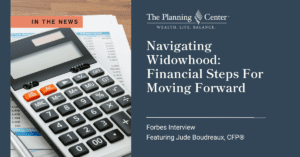
By Michael Branham, CFP® Sr. Financial Planner, Alaska
In 2020, the Federal Reserve released a poll in which people were surveyed about whether they were on track to save enough for retirement. Among respondents 45-59 years old, 44% believed they were on track and among those 60 and older, it was just 51%. The poll was taken during the early stage of the pandemic, and since then, over half of Americans have come to believe that COVID-19 has impacted their ability to achieve a secure retirement.
Good planning requires us to look at retirement income like a complex puzzle we piece together. For instance, in addition to planning for multiple sources of income, you should consider the optimum timing for when to start collecting certain benefits. Here are a few things to think about as you consider how to piece together a plan that’s right for you.
Sources of Retirement Income
Generally speaking, retirement income comes from the following three categories.
- Social Security – Your Social Security benefit should be considered part, but not all, of your retirement plan. On average, retirees report that Social Security benefits account for 40% of retirement income. Having an idea of what your Social Security income will be allows you to plan around that. Your benefits are based on your work history, specifically your highest 35 years of earnings. Benefits are also determined by when you decide to start collecting them. For instance, if you start collecting at age 62, your benefit will be reduced; if you start when you’re 67 years old, you receive your full benefit, and if you wait until you’re 70, you’ll receive an increase from your full benefit.
- Pensions – Nowadays, pensions are mainly a benefit for state and local government employees, with only 16% of private sector employees reporting participation. Even public pensions are declining in size and scope, but they are still an important piece of the retirement puzzle for people in jobs such as teaching, law enforcement, fire fighters, government employees, etc.
- Other Income –This category includes things such as IRAs, 401Ks, cash reserves, income from property or employment, and annuities. Needless to say, it varies dramatically among individuals.
When to Start Collecting Benefits
In addition to planning for different sources of income, you should also have a strategy for when each type of income kicks in. The goal is to coordinate all your various income sources during retirement in a way that covers your needs and maximizes the benefits of each. For example, if you retire early, you might have to wait a while for your pension or your social security benefits to start. There may be periods when you choose to supplement your income by working. We know that at some point you will be forced to take money out of retirement plans under the required minimum distribution rules. There are a multitude of scenarios to take into account and effective timing is part of a good plan.
- Different Phases of Retirement – What retirement looks like at 65 years old, is going to be different from retirement at 85, and income needs will vary accordingly. We identify three different phases for retirement:
- Go-Go Years – Usually the first stage of retirement is when you’re most active. You’re traveling more, socializing more, and entertaining more. More activity usually requires higher income.
- Slow-Go Years – This period is characterized by decreasing activity. You may still be traveling, but not as much. At this point, you’re settling into a slower pace that probably demands fewer resources.
- No-Go Years – This phase tends to be more sedentary, usually due to health issues or physical limitations that are a natural part of aging. If you or a partner has health problems, that can increase the demand on income.
Solving Your Retirement Income Puzzle
While there are a lot of parts and pieces to sort out, good planning makes all the difference. To learn more, view my webinar about Solving the Retirement Income Puzzle, where I discuss things like how to maximize your Social Security benefit, and share tax-efficient withdrawal strategies. It’s part of TPC’s series, Expedition to Retirement which brings together a diverse array of experts who help simplify and clarify the journey to retirement.
As our life expectancy grows, effective planning for retirement has never been more important. Our webinar series shows it can also be fun. If you have questions about any of the webinars, please, contact your TPC team.





